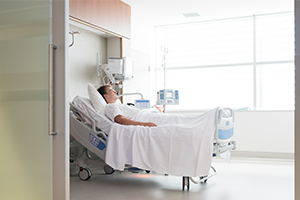Interventional Care


We notice that you are visiting us from . This site only services US-based visitors. Would you like to visit the site that is appropriate for your location?

Point prevalence surveys of healthcare-associated infections (HAIs) provide for a national snapshot of this critical patient safety concern and complement the location- or infection-specific data that infection preventionists report to the National Healthcare Safety Network (NHSN). Utilizing 10 sites in the CDC Emerging Infections Program (EIP) which represents the major geographic sections of the U.S., an initial prevalence survey was conducted in 2011 of 11,282 patients in 183 hospitals and found that 4% of hospitalized patients had an HAI.
In order to assess changes in the HAI prevalence during a time period when intense national attention was placed on HAI reduction targets established by the Department of Health and Human Services (HHS), the survey was repeated in 2015 with 12,299 patients in 199 hospitals. The 10 EIP sites were used, prioritizing the hospitals that participated in the 2011 survey. Each hospital selected 1 day on which a random sample of patients were identified by trained staff utilizing the 2011 HAI definitions. The percentage of patients with HAIs were compared to evaluate the association of survey year with the risk of HAIs.1
In 2015, 3.2% of hospitalized patients experienced an HAI, a 16% decrease compared to the similarly derived estimate in 2011. The most common HAIs were pneumonia and Clostridium difficileinfections, with the biggest reductions in urinary tract and surgical site infections (SSIs)1. Of note, the percentages of patients with a urinary catheter or central line was significantly lower in 2015 than in 2011, reflecting [what can be assumed is] adoption of unnecessary invasive device removal emphasized in HAI prevention bundles. Further, in this survey, fewer patients met the criterion for review of HAI by receiving antimicrobial agents for the treatment of an infection or receiving antimicrobial agents for an undocumented reason than identified in the 2011 survey1. This finding suggests attention to and adoption of antimicrobial stewardship practices. Nearly 40% of HAIs, excluding SSIs, were attributed to critical care units. The most common pathogens reported were Clostridium difficile, S. aureus and E. coli. Among the S. aureus isolates, 45% were methicillin-resistant.1
Similar evidence in improvements in patient safety related to HAIs has been observed with the analysis of NHSN data, which has shown reductions in the standardized infection ratios for central line-associated bloodstream infections (CLABSI), selected SSIs and MRSA bacteremias between 2008 and 20141. Pneumonia, in both ventilated and non-ventilated patients, remains a significant concern with a stable prevalence. Although this survey did not evaluate practice changes, the authors state that the reduction in SSIs may reflect the adoption of perioperative infection prevention practices, such as decolonization of patients with S. aureus colonization or the use of updated surgical antimicrobial prophylaxis guidelines. In respect to C. difficile, the prevalence of infection was stable between 2011 and 2015 and continued focus on antimicrobial use and infection control measures to prevent transmission is needed.1
Looking to the future, focus on further reduction of all HAIs remains a national priority. In addition to monitoring HAI outcome metrics, compliance with process measures that have demonstrated value in HAI reduction efforts are receiving increased attention. Our industry partners in infection prevention are offering products and technologies, along with funded research, that contribute to the goal of HAI elimination. Examples include:
As healthcare facilities continue their efforts to eliminate HAIs, embracing the newer technologies and products that are supported by science in addition to process improvement activities should move the numbers in the right direction. The verdict will be clear when the next prevalence survey results are reported.
1Magill SS, et al. Changes in Prevalence of Health Care– Associated Infections in U.S. Hospitals. N Engl J Med 2018; 379:1732-44.DOI: 10.1056/NEJMoa1801550.
2Flynn JM, Rickard CM, Keogh S, Zhang L. Alcohol Caps or Alcohol Swabs With and Without Chlorhexidine: AnIn VitroStudy of 648 Episodes of Intravenous Device Needleless Connector Decontamination. Infect Control Hosp Epidemiol 2017; 38(5):617-18.
3Phillips M, Rosenberg A, Shopsin B, et al. Preventing surgical site infections: a randomized, open-label trial of nasal mupirocin ointment and nasal povidone-iodine solution. Infect Control Hosp Epidemiol 2014;35(7):826-32.
4Bebko SP, Green DM, Awad SS. Effect of a Preoperative Decontamination Protocol on Surgical Site Infections in Patients Undergoing Elective Orthopedic Surgery With Hardware Implantation. JAMA Surg 2015;150(5):390-395.
5Maslow J, Hutzler L, Cuff G et al. Patient Experience with Mupirocin or Povidone-Iodine Nasal Decolonization. Orthopedics 2014;37(6):e576-e581.
6Anderson, DJ et al. for the CDC Prevention Epicenters Program. Enhanced terminal room disinfection and acquisition and infection caused by multidrug-resistant organisms and Clostridium difficile (BETR-D study): a cluster-randomised, multicentre, crossover study. Lancet 2017 http://dx.doi.org/10.1016/S0140-6736(16)31588-4.